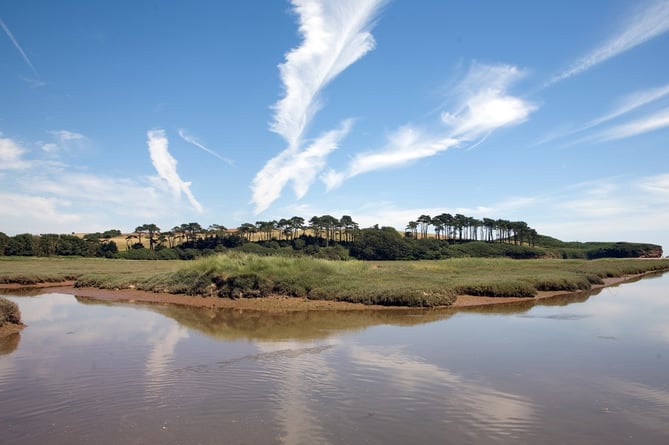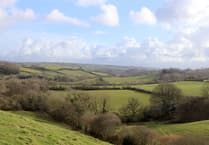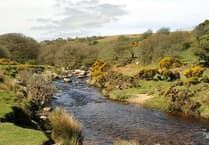NATURAL England and landowners Clinton Devon Estates have today, Friday, February 16, announced the extension to a National Nature Reserve neighbouring Budleigh Salterton, making the Otter Estuary Nature Reserve the third in the new King’s Series of National Nature Reserves.
The Otter Estuary becomes the latest in the “King’s Series” celebrating the Coronation of His Majesty King Charles III and leaving a lasting public legacy for people and nature.
National Nature Reserves are the crown jewels of England`s natural heritage. The King’s Series of National Nature Reserves, will see five major National Nature Reserves named every year for the next five years - 25 in total. NNRs share a commitment to seeing England’s nature restored, enriched and reconnected to people.
The NNR extension brings together the existing 1159ha Pebblebed Heaths NNR, a nationally important lowland heathland managed by the Pebblebed Heaths Conservation Trust (PHCT), RSPB and Devon Wildlife Trust, along with a further 90ha of wetland at the nearby Otter Estuary, cared for by the PHCT on behalf of Clinton Devon Estates.
A total of 50 ha of the newly declared area is inter-tidal habitat created as part of the recently completed Lower Otter Restoration Project (LORP).
The climate change adaptation project has seen major works along the lower Otter valley, reconnecting the river with its floodplain.
Following a 70m breach of an embankment last September, the land is now tidal for the first time in 200 years, making space for nature while safeguarding local infrastructure.
The reserve is becoming increasingly important for rare and declining wetland birds, particularly waders including oystercatcher, curlew, godwits, avocet, and plovers.
Rarer sightings include grey phalarope, spoonbill, green and wood sandpiper, glossy Ibis, ruff and osprey. Water rail and warblers including Cetti’s warbler also breed there.
The reintroduction of tidal flows is allowing the habitat to develop, transitioning to mudflat and saltmarsh.
A range of visiting bird species make use of the increased area to feed. The appearance of each new species or familiar birds in larger numbers has delighted wildlife watchers.
The Pebblebed Heaths NNR lies within the East Devon National Landscape, while the new Otter Estuary reserve also forms part of the Jurassic Coast World Heritage Site and the Otter Estuary Marine Conservation Zone.
The heaths and new wetland share Triassic geology, a key feature of the entire NNR.
The spectacular red sandstone cliffs of the estuary form the oldest part of the Jurassic Coast World Heritage Site, with Otter Head being part of a Site of Special Scientific Interest.
Well-connected to the town and local villages, in excess of 250,00 local people and visitors enjoy the Otter Estuary nature reserve each year using the network of footpaths which run through it, including part of the South West Coast path.
Strong beaver and otter populations exist on the River Otter and the estuary supports populations of sea trout, Atlantic salmon and European eel.
Restoration works during the LORP project has enhanced the ability of fish and other wildlife to move between the Pebblebed Heaths (the source of four tributaries of the River Otter) and the sea. Marine species such as bass, goby, pollock, flounder and thin-lipped mullet are also abundant within the Otter Estuary.
Tony Juniper, Chair of Natural England, said: “The extension of the Pebblebed Heaths National Nature Reserve to encompass the River Otter restoration project is a huge step for nature recovery, not just in Devon, but the country as a whole, with new wetland habitat protected for nature.
“The Otter estuary restoration shows how we can work with nature to deliver multiple benefits from climate change adaptation while supporting internationally important wildlife.
“This ambitious extension to the National Nature Reserve will not only enhance the natural environment, making it a better and more joined up place for wildlife to thrive, but also provide opportunities for locals and visitors alike to connect with the natural world, history and the local heritage.”
Dr Sam Bridgewater, Director of Environment Strategy and Evidence, Clinton Devon Estates said: “We are very proud to have the Otter Estuary recognised as a National Nature Reserve. The recently completed restoration project took over a decade to plan, fund and deliver.
“To have the site’s conservation value recognised in this way makes it all worthwhile. The restoration work could not have been undertaken without the support of the Environment Agency who were our project partners in this endeavour.
“We have been delighted with how nature is thriving in this greatly enhanced and expanded wetland with almost every week bringing a new species sighting.
“It has also been wonderful to see the overwhelmingly positive response from the public who can easily access the site and connect with nature. Over the coming years we will continue to record how the habitats evolve and how wildlife benefits with important research work supported by a strong team of local citizen scientists.
“As well as managing this wonderful reserve, the efforts of our team are now focused on building on the nature gains we have seen with our long-term goal being to go further and create a ‘super’ National Nature Reserve that powers nature recovery across the agricultural hinterlands that link all of the component parts of the Pebblebed Heaths NNR.”
National Nature Reserve status is given to the very best nature conservation sites in England and is recognition that the land is nationally important and will be managed in perpetuity for its wildlife and geology.
Many National Nature Reserves are managed by multiple parties also known as Approved Bodies who are committed to working together towards a shared future vision for the Nature Reserve.
Clinton Devon Estates is the Approved Body for the entire Pebblebed Heaths NNR, with Devon Wildlife Trust and the RSPB also Approved Bodies for the previously declared area.
Read more about the power of National Nature Reserves in this blog by Tony Juniper.




